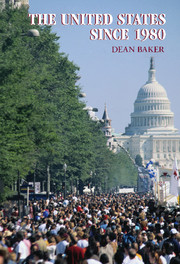Book contents
- Frontmatter
- Contents
- List of Figures and Tables
- Preface
- Acknowledgments
- 1 Turning Away: The United States Breaks Ranks
- 2 Setting the Scene: The United States in 1980
- 3 The Reagan Revolution: Running to the Right
- 4 The Reagan Revolution Becomes Institutionalized
- 5 The Republican Tidal Wave and the Clinton Boom
- 6 The Bush Administration and the War on Terrorism
- 7 The United States in 2005: The Impact of the Last Quarter Century
- Epilogue: Different Directions, Missed Opportunities
- Bibliography
- Index
Epilogue: Different Directions, Missed Opportunities
Published online by Cambridge University Press: 29 July 2009
- Frontmatter
- Contents
- List of Figures and Tables
- Preface
- Acknowledgments
- 1 Turning Away: The United States Breaks Ranks
- 2 Setting the Scene: The United States in 1980
- 3 The Reagan Revolution: Running to the Right
- 4 The Reagan Revolution Becomes Institutionalized
- 5 The Republican Tidal Wave and the Clinton Boom
- 6 The Bush Administration and the War on Terrorism
- 7 The United States in 2005: The Impact of the Last Quarter Century
- Epilogue: Different Directions, Missed Opportunities
- Bibliography
- Index
Summary
History does not offer second chances, but it can nonetheless be informative to ask whether over the last quarter century the United States could have chosen a different path than the one it actually pursued. The election of 1980 was a major turning point for the United States, as the Reagan presidency reversed many of the key trends of the postwar period. Reagan administration policies substantially weakened union power and undermined the bargaining position of less-educated workers. They also limited and partially reversed the growth of the welfare state.
Internationally, the Reagan administration pushed the United States in a more unilateralist direction. Rather than trying to construct an international institutional framework that might constrain U.S. power in some ways but could ultimately protect U.S. interests, the Reagan administration largely pursued a go-it-alone strategy. This is perhaps best exemplified by its determination to overthrow the Nicaraguan government, an enterprise in which it was unable to enlist the open support of any major ally. The United States has moved further along this unilateralist path in the years since Reagan left office.
The question is whether a different direction was possible. Most immediately, it was not inconceivable that Carter would have been reelected. The polls indicated that it would be a close race until the final few weeks before the election. Certainly if President Carter had managed to arrange for an October celebration on the White House lawn with the newly freed hostages from Iran, there would have been a very good chance that he would have been reelected.
- Type
- Chapter
- Information
- The United States since 1980 , pp. 237 - 244Publisher: Cambridge University PressPrint publication year: 2007

